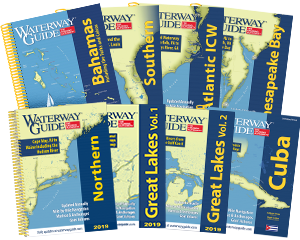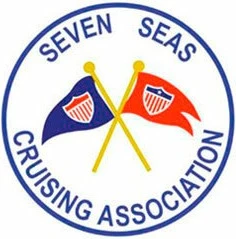
Anyone planning to cruise our waterways should make themselves familiar with the rules of the road. Chapman Piloting: Seamanship and Small Boat Handling and The Annapolis Book of Seamanship are both excellent on-the-water references with plentiful information on navigation rules.
For those with a penchant for the exact regulatory language, the Coast Guard publication Navigation Rules: International–Inland covers both international and U.S. inland rules. (Boats over 39.4 feet are required to carry a copy of the U.S. Inland Rules at all times.) These rules are available online from the U.S. Coast Guard Navigation Center.
The following is a list of common situations you will likely encounter on the waterways. Make yourself familiar with them, and if you ever have a question as to which of you has the right-of-way, let the other vessel go first.
Sailors need to remember that a boat under sail with its engine running is considered a motorboat.
Passing or being passed:
- If you intend to pass a slower vessel, try to hail them on your VHF radio to let them know you are coming.
- In close quarters, BOTH vessels should slow down. Slowing down normally allows the faster vessel to pass quickly without throwing a large wake onto the slower boat.
- Slower boats being passed have the right-of-way and passing vessels must keep clear of these slower vessels.
- As you pass a slower boat, take a look back to see how they were affected by your wake. Remember: YOU are responsible for your wake. It is the law to slow down, and it is common courtesy.
At opening bridges:
- During an opening, boats traveling with the current go first and generally have the right-of-way.
- Boats constrained by their draft, size or maneuverability (e.g., dredges, tugs and barges) also take priority.
- Standard rules of the road apply while circling or waiting for a bridge opening.
Tugs, freighters, dredges and naval vessels:
- These vessels are usually constrained by draft or their inability to easily maneuver. For this reason, you will almost always need to give them the right-of-way and keep out of their path.
- You must keep at least 100 yards away from any Navy vessel. If you cannot safely navigate without coming closer than this, you must notify the ship of your intentions over VHF Channel 16.
- Keep a close watch for freighters, tugs with tows and other large vessels while offshore or in crowded ports. They often come up very quickly, despite their large size.
- It is always a good practice to radio larger vessels (VHF Channel 13 or 16) to notify them of your location and your intentions. The skippers of these boats are generally appreciative of efforts to communicate with them. This is especially true with dredge boats on all the waterways.
In a crossing situation:
- When two vessels under power are crossing and a risk of collision exists, the vessel that has the other on her starboard side must keep clear and avoid crossing ahead of the other vessel.
- When a vessel under sail and a vessel under power are crossing, the boat under power is usually burdened and must keep clear. The same exceptions apply as per head-on meetings.
- On the Great Lakes and western rivers (e.g., the Mississippi River system), a power-driven vessel crossing a river shall keep clear of a power-driven vessel ascending or descending the river.
Power vessels meeting any other vessel:
- When two vessels under power (either sailboats or powerboats) meet “head-to-head,” both are obliged to alter course to starboard.
- Generally, when a vessel under power meets a vessel under sail (i.e., not using any mechanical power), the powered vessel must alter course accordingly.
- Exceptions are vessels not under command, vessels restricted in ability to maneuver, vessels engaged in commercial fishing or those under International Rules, such as a vessel constrained by draft.
Two sailboats meeting under sail:
- When each has the wind on a different side, the boat with the wind on the port side must keep clear of the boat with the wind on the starboard side.
- When both have the wind on the same side, the vessel closest to the wind (windward) will keep clear of the leeward boat.
- A vessel with wind to port that sees a vessel to windward but cannot determine whether the windward vessel has wind to port or starboard will assume that windward vessel is on starboard tack and keep clear.
Keep Watch for Crab Pots!
While crab pots with marker buoys are not usually intentionally placed inside navigational channels, they sometimes break loose and find their way there. The terms “pot” refers to the enclosed traps (usually a framework of wire) used to catch crabs in shallow waters. The attached retrieval markers can range from colorful buoys to empty milk jugs (or anything else that floats). Most buoys are painted in a color that contrasts the water surface, but some are black or even dark blue, which are especially difficult to see in the best of conditions. You do NOT want to get a line wrapped around your prop, so it is advisable to have a spotter on the foredeck when traversing fields of pots.











